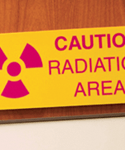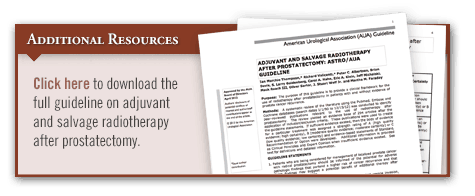Radical prostatectomy (RP) is the most common primary treatment for localized prostate cancer. For most men, the surgery will cure the disease, but up to one-third of patients will present with recurrent prostate cancer within 10 years of RP. The risk of prostate cancer recurrence after RP is greater among men with adverse pathology. “In high-risk patients, clinicians and patients must determine if adjuvant therapy is a consideration to prevent future recurrence,” explains Ian Murchie Thompson, Jr., MD. “In post-surgical patients who later present with detectable PSA levels, appropriate salvage therapies may be considered.”
In 2013, the American Society for Radiation Oncology (ASTRO) and the American Urological Association (AUA) published a joint guideline for using adjuvant and salvage radiation therapy after RP in patients with and without evidence of prostate cancer recurrence. The guideline represents an intensive collaboration among experts in radiation oncology and urology.
Informing Patients
According to Dr. Thompson, who co-chaired the ASTRO/AUA writing group, educating patients is of the utmost importance. “Patients need to be informed of the potential for adverse pathologic findings that raise their risk of disease recurrence,” he says. “If adverse pathologic findings emerge, patients should understand that adjuvant radiation therapy can help reduce the risk of biochemical recurrence, local recurrence, and clinical disease progression.”
The effectiveness of radiation therapy for disease recurrence is greatest when given at lower PSA levels, says Dr. Thompson. “Patients should be informed that PSA recurrence after surgery correlates with a higher risk of metastatic prostate cancer or death from the disease. They also need to know about the possible short- and long-term urinary, bowel, and sexual side effects of radiation therapy as well as the potential benefits of controlling disease recurrence.”
The ASTRO/AUA guideline recommends that clinicians define biochemical recurrence as a detectable or rising PSA value after surgery that is 0.2 ng/ml or higher; a second confirmatory PSA level should also be 0.2 ng/ml or higher. If PSA levels rise after surgery, a restaging evaluation should be considered. Salvage radiation therapy should be offered to patients with PSA or local recurrence after RP if there is no evidence of distant metastatic disease.
Reaching Goals
Dr. Thompson says the ASTRO/AUA guideline is intended to help clinicians with reaching the ultimate goal of increasing patient survival and quality of life. “This guideline provides a practical approach to guide patients in decision making,” he says. “The guideline is a living manifesto of our efforts to optimize patient care and outcomes. As more evidence emerges, it will be updated regularly.”




 admin
admin